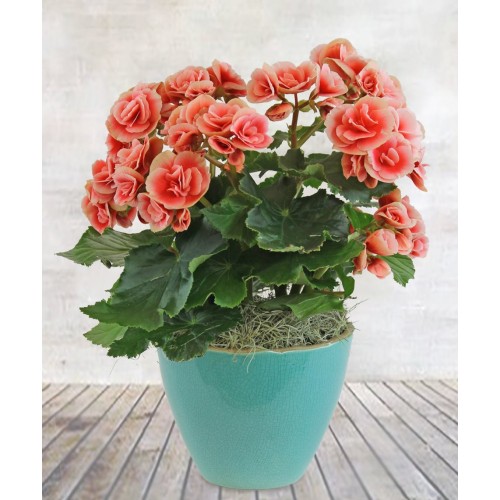The Begonia originates from the South America region, the begonia plat takes the largest portion of the cane begonia plants. These particular plants have elongated stems that contain joints from which leaves and flowers grow. The leaves of this plant are large, angel shaped, dark green with metallic silver specks with a deep red underside.
The flowers of the wing begonia plants are produced in clusters and shades of red, white, orange and pink. The color intensity of the flower will often depend on the amount of light the plant was exposed to. The plant is beautiful and easy to care for as well as maintain. On the downside, the plant is highly poisonous and should, therefore, be kept away from pets and children.
Care
· The wing begonias need adequate bright indirect light to enhance the color of the flowers and flowering process. Intense lighting makes the leaves to curl.
· For small pots, allow the top 1-inch layer of the soil to dry before watering and 2-3 inches for larger pots. Ensure the pot has drip holes for proper drainage. Also, over-watering turns the leaves yellow, and they fall off.
· The plant should be fed monthly with liquid plant food that is high in potassium in spring and summer when it’s growing. The soil should be damp ad food diluted by half to prevent leaf burn.
· The ideal temperature for the survival of angel wing begonia is 65-75 degrees. 50 degrees and below will harm the flower and leaves.
· The plant can easily survive in the average household humidity. Avoid misting the plant as wed leaves encourage powdery mildew and leaf spots diseases.
· More flowers are encouraged with bright indirect light and fertilizers that are rich in potassium.
· Mealybugs are a threat to the angel wing begonias. Green solution or commercial insecticidal soap is recommended over toxic chemicals that can damage the leaves.
· Plant bacteria may cause leaf spot that is manifested as yellow halos that come as a result of wet plant leaves or soggy soil. Cutting the infected leaf and improving air circulation is the recommended remedy.
· The plant needs heavy soil like African violet soil mix to support large root system and tall stems.
· The pot size should be 1-2 inches larger than the root ball and made of heavy clay or ceramic with drip holes to support the weight and for drainage.
· The older growth on the plant should be pruned annually during winter or early spring to prevent having a leggy plant. You can re-pot it and get rid of dead flowers and leaves.
· Stem cutting is used for propagation where3-5 inches section of the non-flowering stems are cut into pieces with 2-4 nodes on it. They are dipped in rooting hormone and planted in small containers of perlite or sand.
· The plant contains level 1 toxicity due to the presence of oxalates.
FAQs
Why are the leaves of my angel wing begonia plant turning yellow? Does it need more food?
Yellowed leaves are as a result of over-watering. Try and allow the top few inches of the soil to dry out before watering and keep the leaves dry.
How do I get to stop my plant from getting crunchy brown edges on its leaves?
Ensure the plant is exposed to enough humidity without misting.
Visit Toronto Office Plant today and you will gain access to even more options of some of the best office plants preferred by most clients.
Begonia
- Product Code: KZ508-31
- Availability: In Stock
-
$58.99







